So, I always wondered if anyone was actually nerdy enough to run these things on the pantographs - for real.
Anyone?
Marty Fizthenry and a few others run their electrics off the wire. I plan to someday if I can get the track down first. It's a great way to do command control without the need for a control system. One could even run an all electric RR on 2R track with the live wire just like the prototype.
It's like this, if I'm nerdy enough to have over 60 of these models in 0, HO and N, I'm certainly up for the challenge of doing a live wire catenary system some day. I'm not quite yet 40, so I have a little time to work it out.
There is even a web site that distinguishes the differences in details for the major electrification projects in the US. For example the trolley wire on PRR electrification utilized two wires in a vertical position while others, such as the famous NH triangluar wire did not. Unfortunately I do not ave the link for this site on this computer.
The biggest challenge for a scale modeler is finding the correct poles, messenger wires, and catenary style for your prototype. The out of the box systems are not scaled properly and fabricating one is quite the challenge.
I have seen many examples of good live catenary in HO because Marklin makes a great out of the box system.
It's like this, if I'm nerdy enough to have over 60 of these models in 0, HO and N, I'm certainly up for the challenge of doing a live wire catenary system some day. I'm not quite yet 40, so I have a little time to work it out.
There is even a web site that distinguishes the differences in details for the major electrification projects in the US. For example the trolley wire on PRR electrification utilized two wires in a vertical position while others, such as the famous NH triangluar wire did not. Unfortunately I do not ave the link for this site on this computer.
The biggest challenge for a scale modeler is finding the correct poles, messenger wires, and catenary style for your prototype. The out of the box systems are not scaled properly and fabricating one is quite the challenge.
I have seen many examples of good live catenary in HO because Marklin makes a great out of the box system.
quote:Originally posted by GG-1 4877:
It's like this, if I'm nerdy enough to have over 60 of these models in 0, HO and N, I'm certainly up for the challenge of doing a live wire catenary system some day. I'm not quite yet 40, so I have a little time to work it out.
The biggest challenge for a scale modeler is finding the correct poles, messenger wires, and catenary style for your prototype. The out of the box systems are not scaled properly and fabricating one is quite the challenge.
Good luck in your quest!
For anyone interested in doing scale catenary systems, here is a link to an excellent website for information:
The Ultimate Catenary Site
The Ultimate Catenary Site
Two must see prototype GG! videos that were brought to our attention in Mike R's Dryfus thread. The videos follow GG1's in Congressional service and some great footage of GG1's being serviced. Check out the GG1 at the 2:25 mark in part one with it's boiler popping off some excess pressure! Hey my MTH GG1s do that!
http://www.youtube.com/watch?v...RDyQ&feature=related
http://www.youtube.com/watch?v...QK9Q&feature=related
Tom
http://www.youtube.com/watch?v...RDyQ&feature=related
http://www.youtube.com/watch?v...QK9Q&feature=related
Tom
Check out this nice weathering job.
quote:Originally posted by corsair29:
Steve C.
I saw the Lionel JLC tuscan red single stripe GG1 at Strasburg over the holidays. Man that thing is ugly. The silver one is a beauty by comparison.
Chessie Man - There were only two GG1's painted in this scheme anyway - 4907 and 4916. I don't think they lasted long in service in that color scheme. Perhaps 2-3 years at most.
I related it on another page of this thread. When Kruschev came to the US to meet with President Eisenhower, he was quite angry that his train from NYC to DC received two DGLE single stripe GG1's, not red ones!
Just to show some more of these wonderful machines, some older shots from my collection not posted in this thread - first the all scales images:
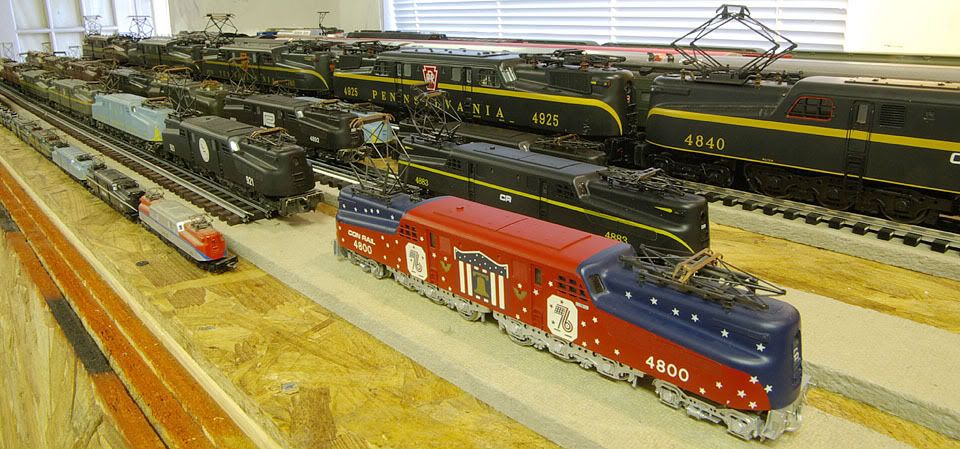
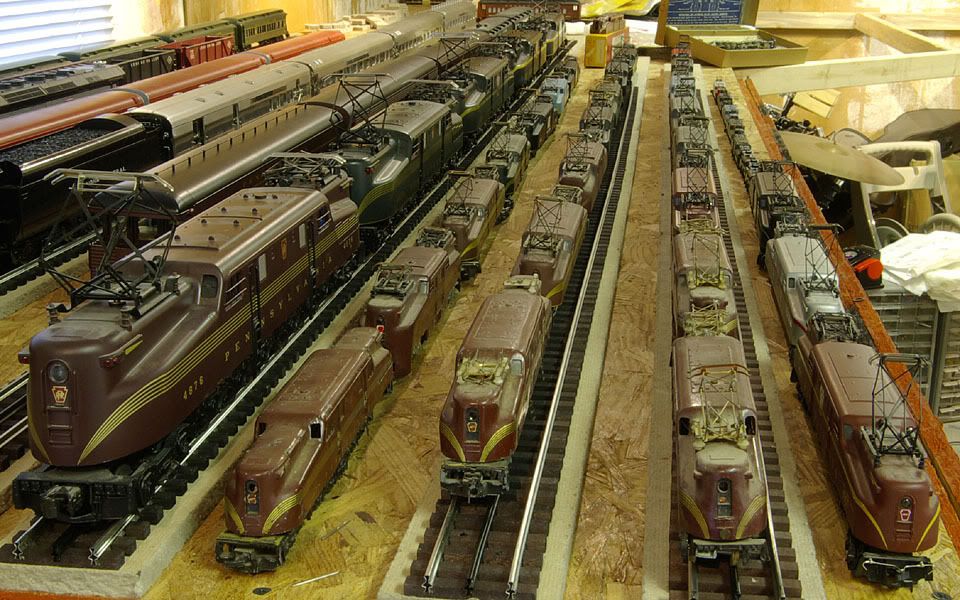
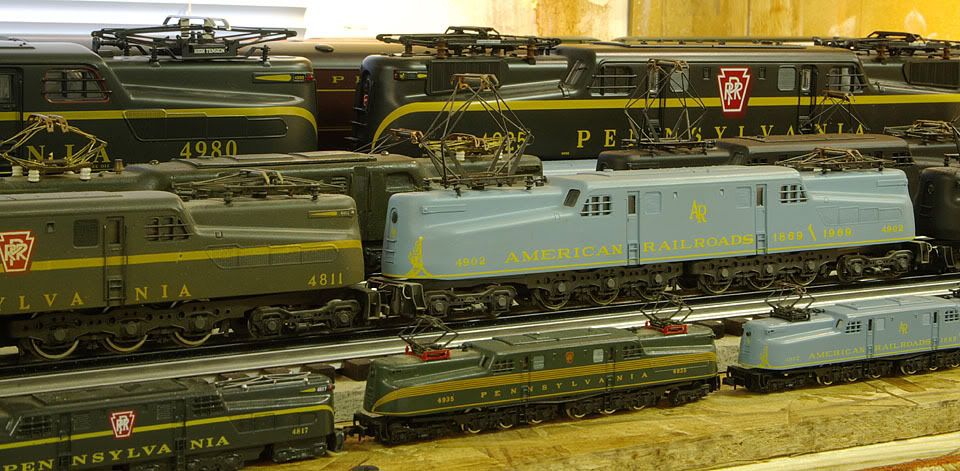
An E33 digging in with two Conrail G's:
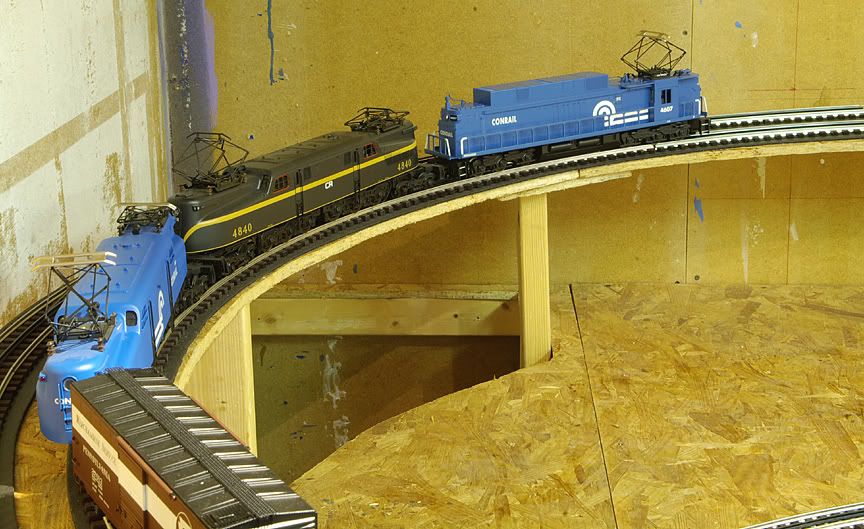
I related it on another page of this thread. When Kruschev came to the US to meet with President Eisenhower, he was quite angry that his train from NYC to DC received two DGLE single stripe GG1's, not red ones!
Just to show some more of these wonderful machines, some older shots from my collection not posted in this thread - first the all scales images:



An E33 digging in with two Conrail G's:

When did Mr "K" make this trip on the train. I remember quite distinctly standing beside the Suitland Parkway and "capturing" the attention of the SS because of a small box with electronics I was holding. Mr. "K" went from Andrews AFB to Washington via the Suitland Parkway. I saw his motorcade.IT may be possible that he landed at AAFB, motored to Washington and some how went to NYC and took the train back to DC. WAs this the same time as the shoe incident at the U.N.?
Al W.
Al W.
Hi Al! From the book "The Pennsylvania Railroad- Under Wire" was this photo and caption.

A much watched train was this special train. which carried premier Nakita Kruschev and a Soviet delegation from New York to Washington on September 17, 1959. GG1s 4910 and 4905 powered the 15-car train of Congressional equiptment, seen here crossing Kearny Meadows just outside Harrison, NJ. Don Wood Photo
Tom

A much watched train was this special train. which carried premier Nakita Kruschev and a Soviet delegation from New York to Washington on September 17, 1959. GG1s 4910 and 4905 powered the 15-car train of Congressional equiptment, seen here crossing Kearny Meadows just outside Harrison, NJ. Don Wood Photo
Tom
Digging through my hard drive and I forgot I cut this out of the Asbury Park Press as a kid after I took the ride. Not the best of reporting, but at least they didn't call it a caboose 
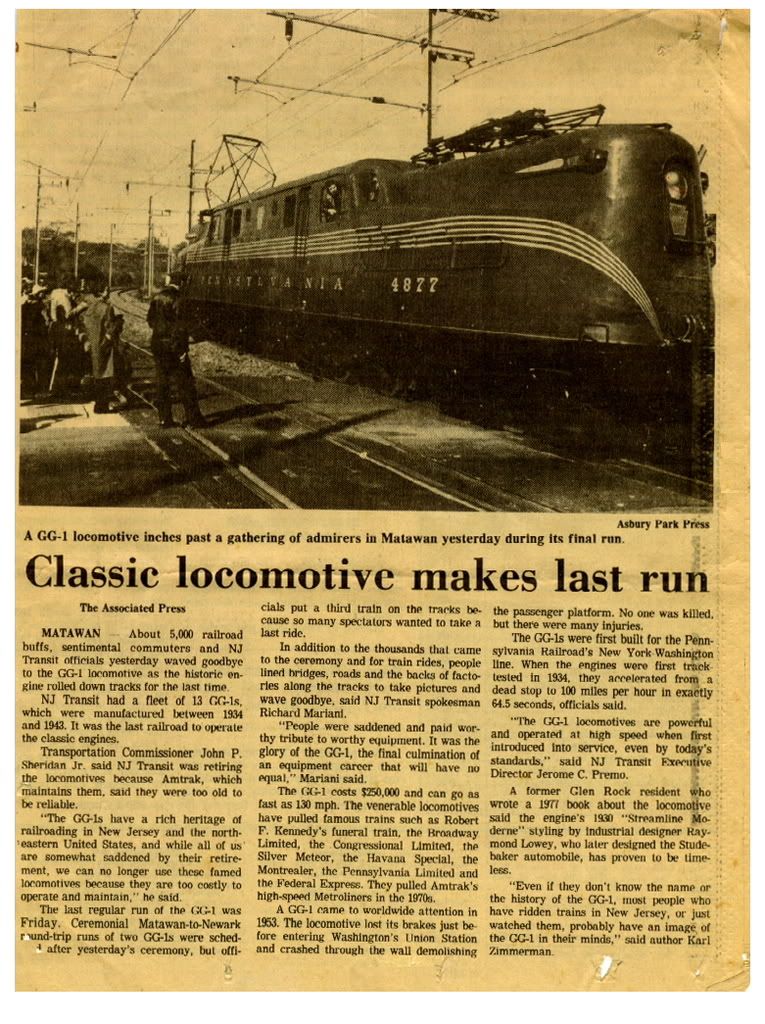

Thanks Chessie Man. Here's a green one.

Steve C.
Steve C.
Steve,
Very nice work indeed. GG1s as they should be - dirty! Thanks for the post.
Very nice work indeed. GG1s as they should be - dirty! Thanks for the post.
Awwww. Not when they were in DGLE 5-stripe. Maybe slightly dusty, but NOT dirtyquote:Very nice work indeed. GG1s as they should be - dirty! Thanks for the post.
In the late 60's and early 70's my mom would take us to meet my dad at the Linden NJ. station. GG1's were the regular power. I can't recall ever seeing a clean one.
Steve C.
Steve C.
Steve,
I have to agree with you, it all depends on what period you model. Starting in the mid 50's the G's starting hitting the wash rack less. While they all cleaned up pretty nice with some attention, they were your typical dirty PRR equipment.
The 5 stripe DGLE scheme was slowly phased out in the 50's, but several survived longer and looked much like your version. As GG1's were transfered into freight duties, they simply didn't see the wash rack. By 1967 before the merger, every G 4866 and under was geared for freight work. GG1 4804 was the last one to loose its PRR 5 stripe DGLE paint ... in 1974. It was pretty dirty by then.
However, Rex is also correct that the PRR did maintain the pride of their fleet very well including regular cleaning up into the 50's. After that it was a little more hit and miss. I've seen images of spotless PC ones as well.
Still love the weathering job.
I have to agree with you, it all depends on what period you model. Starting in the mid 50's the G's starting hitting the wash rack less. While they all cleaned up pretty nice with some attention, they were your typical dirty PRR equipment.
The 5 stripe DGLE scheme was slowly phased out in the 50's, but several survived longer and looked much like your version. As GG1's were transfered into freight duties, they simply didn't see the wash rack. By 1967 before the merger, every G 4866 and under was geared for freight work. GG1 4804 was the last one to loose its PRR 5 stripe DGLE paint ... in 1974. It was pretty dirty by then.
However, Rex is also correct that the PRR did maintain the pride of their fleet very well including regular cleaning up into the 50's. After that it was a little more hit and miss. I've seen images of spotless PC ones as well.
Still love the weathering job.
No thanks to Jonathan,  I have seven scale GG1s. How many to you folks have?
I have seven scale GG1s. How many to you folks have?
JLC Silver issue... will be looking for a Green single stripe very soon..
Sure, here I am going broke due to the recession and you guys are going to pass me on the scale 0 GG1's 
I feel my work is nearly done here
Now that I'm back in practice a few will be heading through the weathering shop. Don't worry the Conrail 4840 is first ...
I feel my work is nearly done here
Now that I'm back in practice a few will be heading through the weathering shop. Don't worry the Conrail 4840 is first ...
Great thread guys.
This photo reminds me of the Semi trucks that drive under too low of clearance overpasses and get wedged under them.

This photo reminds me of the Semi trucks that drive under too low of clearance overpasses and get wedged under them.
Finally weathered the Conrail 4840. I worked off photographs available online.
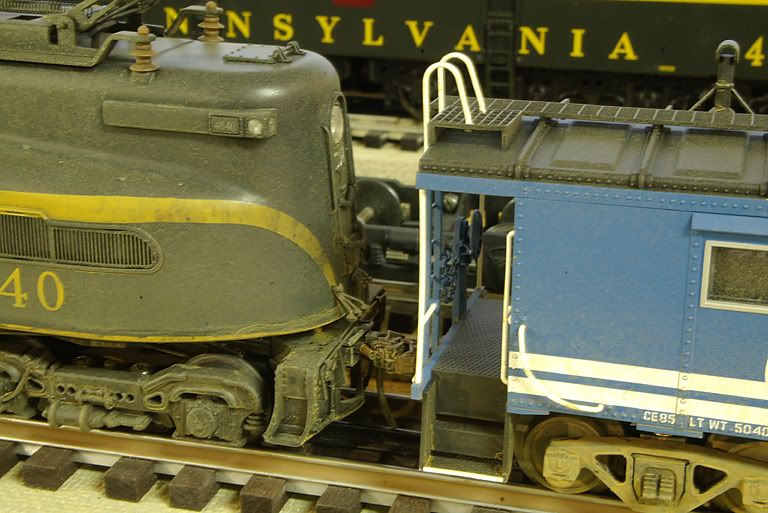

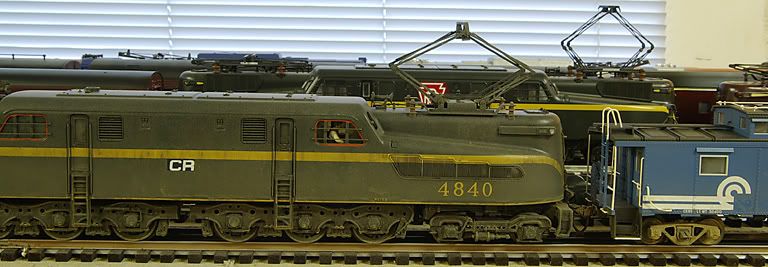

I forgot to add the prototype photo ..... CR GG1 4840




I forgot to add the prototype photo ..... CR GG1 4840
quote:Jonathan
Nice Jonathan, looks like they really need a bath...
Cheers !
Jac
Here's a quuestion I haven't seen answered: What does the GG stand for? (and don't say "Good Grief!" Charlie Brown).
The Pennsy assigned a letter of the alphabet, (A thru T), to each steam or electric locomotive wheel arrangement. As an example an 0-4-0 was classified as an “A”, a 4-6-2 Pacific was a “K”, a 4-6-0 Ten Wheeler was a “G”. Since the GG1’s wheel arrangement was essentially two back to back Ten Wheelers it was as assigned the designation GG. Since it was the first of that wheel arrangement the 1 was added, hence “GG1.
Here’s a list of Pennsy wheel arrangement designations:
A ... 0-4-0 (Shifter)
B ... 0-6-0 (Shifter)
C ... 0-8-0 (Shifter)
D ... 4-4-0 (American
DD ... 4-4-0+0-4-4 (Electric)
E ... 4-4-2 (Atlantic)
F ... 2-6-0 (Mogul)
FF .. 2-6-0+0-6-2 (Electric)
G ... 4-6-0 (Ten Wheeler)
GG .. 4-6-0+0-6-4 (Electric)
H ... 2-8-0 (Consolidation
I ... 2-10-0 (Decapod)
J ... 2-10-4 (Texas)
K ... 4-6-2 (Pacific)
L ... 2-8-2 (Mikado)
M ... 4-8-2 (Mountain)
N ... 2-10-2 (Santa Fe0
0 ... 4-4-4 (Electric)
P ... 4-6-4 (Electric)
Q ... 4-6-4-4 or 4-4-4-6-4 (Duplex)
R ... 4-8-4 (Electric)
S ... 6-8-6 (Duplex or Turbine)
T ... 4-4-4-4 (Duplex)
Here’s a list of Pennsy wheel arrangement designations:
A ... 0-4-0 (Shifter)
B ... 0-6-0 (Shifter)
C ... 0-8-0 (Shifter)
D ... 4-4-0 (American
DD ... 4-4-0+0-4-4 (Electric)
E ... 4-4-2 (Atlantic)
F ... 2-6-0 (Mogul)
FF .. 2-6-0+0-6-2 (Electric)
G ... 4-6-0 (Ten Wheeler)
GG .. 4-6-0+0-6-4 (Electric)
H ... 2-8-0 (Consolidation
I ... 2-10-0 (Decapod)
J ... 2-10-4 (Texas)
K ... 4-6-2 (Pacific)
L ... 2-8-2 (Mikado)
M ... 4-8-2 (Mountain)
N ... 2-10-2 (Santa Fe0
0 ... 4-4-4 (Electric)
P ... 4-6-4 (Electric)
Q ... 4-6-4-4 or 4-4-4-6-4 (Duplex)
R ... 4-8-4 (Electric)
S ... 6-8-6 (Duplex or Turbine)
T ... 4-4-4-4 (Duplex)
From...
http://www.trainnet.org/Libraries/Lib006/GG1DATA.TXT
The Pennsy's road class designation "GG-1" was derived from the steam
loco class G, which was used for 4-6-0 ten-wheelers. Pennsy brass apparently
viewed their successful electric locomotive as a pair of 4-6-0 ten-wheelers
placed back-to-back, and this gave the "GG" prefix. Since it was the first
such loco designed, the "1" went in at the tail end to make it the "GG-1".
http://www.trainnet.org/Libraries/Lib006/GG1DATA.TXT
The Pennsy's road class designation "GG-1" was derived from the steam
loco class G, which was used for 4-6-0 ten-wheelers. Pennsy brass apparently
viewed their successful electric locomotive as a pair of 4-6-0 ten-wheelers
placed back-to-back, and this gave the "GG" prefix. Since it was the first
such loco designed, the "1" went in at the tail end to make it the "GG-1".
Actually it's "GG1." There is no dash.
Thanks! Amazing the knowledge that's available on this forum.
quote:Originally posted by SoCalStu:
Thanks! Amazing the knowledge that's available on this forum.
While the PRR steam nomenclature was pretty rigid there are some odd gaps.
For example on the L series Mikados the L2 was the limit of steam development with the L2 a USRA design the PRR hated and disposed of as fast as they could. The L6 was an unsuccessful electric boxcab where the two built lived their lives in Penn Station, NY switching service. What happened to the L3-L5?
Also the P5 was the lone 4-6-4 design on the roster. Where were the P1-P4 designs? The Hudson was not a good design for the PRR's mountain grades, but still a valid question.
Why did the PRR develop the lone R1 as an electric, but never saw the benefit of the 4-8-4 in steam? An R2 would likely have been much more reliable and simple over the T1 or Q2 series duplexes.
Inquiring minds need to know!
Totally trivial, but during the early 50's rumors were rampant that the PRR would extend electrification to Pittsburg and develop a 'super GG1'. It would have likely been a GG2 or GG3 had it ever been developed and mainline frieght electric operations might actually be still in service. An outside chance at best, but still a remote possibility.
quote:Originally posted by corsair29:
In the late 60's and early 70's my mom would take us to meet my dad at the Linden NJ. station. GG1's were the regular power.
Steve C.
Geesh, I used to visit my grandparents who lived in Linden, NJ (St. Georges Avenue).
I was much too young to know about "real" trains, at the time... and I don't recall where the Linden station was located. But I wish I did, and had !!!
P.S.
Did you know........ that in 44 days, this thread will celebrate it's first birthday ???
Gee.... in just a few years, this thread will have lasted as long as the GG1's !!!
[/QUOTE]
Geesh, I used to visit my grandparents who lived in Linden, NJ (St. Georges Avenue).
Alan, My grand parents were also from Linden (knoph st.) The station was on Wood Ave. about 10 blocks from St Georges Ave.
Steve C.
Geesh, I used to visit my grandparents who lived in Linden, NJ (St. Georges Avenue).
Alan, My grand parents were also from Linden (knoph st.) The station was on Wood Ave. about 10 blocks from St Georges Ave.
Steve C.
Just heard from Marty at MA & PA Junction that my first scale GG1 will be shipped soon - a WBB green 5 stripe. Can't wait. All I have now is max O42 curves which it's said this engine will negotiate, but at least I can finally say I have a true scale GG1!
Are there any reports on long term operation of the Lionel JLC scale GG1s? How reliable are they in your experiences?
>>quote:Are there any reports on long term operation of the Lionel JLC scale GG1s? How reliable are they in your experiences?
Mine came damaged in the box with a broken coupler but was immediately exchanged with the dealer.. I've been playing with it since Christmas and all is well.. the kicker on this thing ( I love it )is the squeaking sounds when the pantographs operate.. Very nice operating sounds with a plenty of volume..
4877:
You have 2 G's mu'ed to a E33 or 44 in a picture. I thought G's could mu only to G's!
You have 2 G's mu'ed to a E33 or 44 in a picture. I thought G's could mu only to G's!

quote:You have 2 G's mu'ed to a E33 or 44 in a picture. I thought G's could mu only to G's!
During the mid to late 60's it was common practice to MU regeared GG1's occassionally with a couple of E44's. This continued through to Conrail. They were compatible, but PC and CR practice was to try to match units when possible. Typically the E33's stayed together, while the E44's and G's mingled from time to time. I don't have an E44 yet, so the E33 had to do since I've got 4 of those.
I have several copies of a classic photo of GG1 pulling lead with the front pantograph up and the rear one down with three RS3's and a long string of freight behind it. Sadly, there is another image during the Amtrak era with an GG1 being pulled by two Amtrak RS3's and both pantographs down
It is a real pleasure reading this thread. I don't have any O GG-1's (I have two in N scale) but I also have a brief story that I'd like to share, and my apologies if it doesn't belong here:
When I was about 10 years old my father took me to Penn Station to look at the trains. The old Penn Station was still there. Down on the platform there was a train awaiting departure, with a GG-1 at the head. The platform area was pretty dark, and the GG-1 was dark and grimy, so to a 10-year old this engine looked like some kind of colossal dark Moby Dick sitting there whining and snapping and clicking.
There was an engineer in the cab looking at us. He asked me if I would like to come up into the cab. Once inside, he let me move one of the handles - he said I was releasing the brakes, although now that I think of it that sounds pretty impossible, but it was a long time ago. I moved the handle and heard some kind of sound coming from far away in the train somewhere. The view ahead from the cab down the side of the engine and off into the dark was extraordinary.
I got back down on the platform, and he asked me if I had a nickle in my pocket. Back then that meant an Indian Head nickle. I did, and he said that he had met the man that posed for the profile that appeared on the nickle.
It's amazing that I can't remember what I had for dinner yesterday and yet I can remember my visit to a GG-1 cab so well. Thanks to all the posters on this thread for the tremendous pictures and stories of the model and real GG-1's.
When I was about 10 years old my father took me to Penn Station to look at the trains. The old Penn Station was still there. Down on the platform there was a train awaiting departure, with a GG-1 at the head. The platform area was pretty dark, and the GG-1 was dark and grimy, so to a 10-year old this engine looked like some kind of colossal dark Moby Dick sitting there whining and snapping and clicking.
There was an engineer in the cab looking at us. He asked me if I would like to come up into the cab. Once inside, he let me move one of the handles - he said I was releasing the brakes, although now that I think of it that sounds pretty impossible, but it was a long time ago. I moved the handle and heard some kind of sound coming from far away in the train somewhere. The view ahead from the cab down the side of the engine and off into the dark was extraordinary.
I got back down on the platform, and he asked me if I had a nickle in my pocket. Back then that meant an Indian Head nickle. I did, and he said that he had met the man that posed for the profile that appeared on the nickle.
It's amazing that I can't remember what I had for dinner yesterday and yet I can remember my visit to a GG-1 cab so well. Thanks to all the posters on this thread for the tremendous pictures and stories of the model and real GG-1's.
Joe,
That is a great story. It definitely speaks to a better time hanging out around the railroads when crews and staff were permitted to be friendly and really helped promote the railroad. Definitely a stark contrast to today when even a simple picture can get you into trouble.
Thanks for sharing!
That is a great story. It definitely speaks to a better time hanging out around the railroads when crews and staff were permitted to be friendly and really helped promote the railroad. Definitely a stark contrast to today when even a simple picture can get you into trouble.
Thanks for sharing!
Hello all. Here's my first scale GG1, a Williams BB I purchased from MA & PA Junction. I thought in all the literature I saw that the road number would be 4935, but I like it anyway.





These pictures of scale GG1s are great. In looking at them, however, I wonder if some have the front mislabeled? The little F, as I understand it, should be at the end that has the steam generator stack on the roof. Do some have the F at the other end?
The Amtrak GG1s that I have seen pictures of all seem to have the steam generator stack covered by a smoke deflector; also they have a Sinclair radio antenna on the roof (not on the hatches). These must be later modifications.
The Amtrak GG1s that I have seen pictures of all seem to have the steam generator stack covered by a smoke deflector; also they have a Sinclair radio antenna on the roof (not on the hatches). These must be later modifications.
Add Reply
Sign In To Reply


